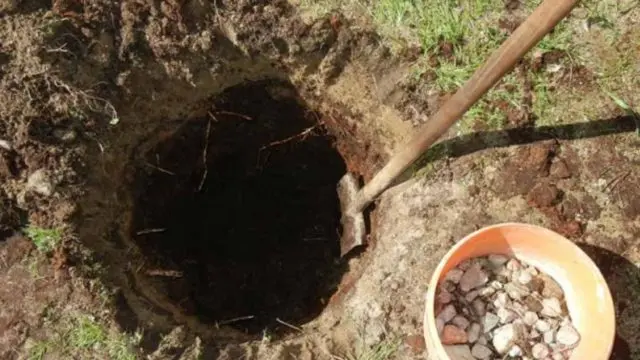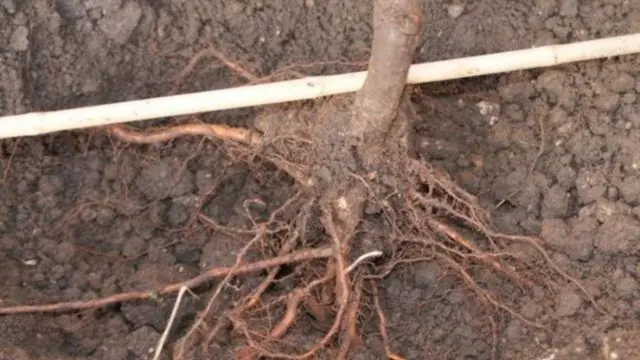Contents
The apple tree variety Kitayka golden is an unusual type of culture, the fruits of which are popularly called “paradise apples”. The tree itself also has highly decorative qualities, which is why it is widely used in landscape design. At the same time, this culture is characterized by increased frost resistance and undemanding care, so it can often be found in household plots.
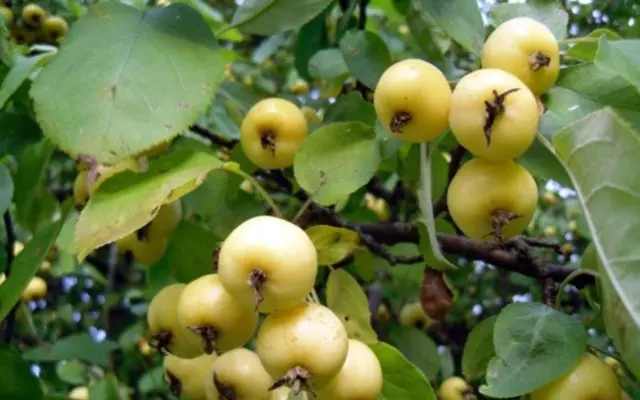
Golden Chinese is especially pleasing to the eye during flowering and fruit ripening
Description of the apple tree variety Kitayka Golden
There are many types of Kitayek, but this variety stands out noticeably against their background in the color of its fruits, as well as other characteristics. Therefore, its main features should be studied, which will allow each gardener to get a complete picture of it.
History of breeding
The Golden Kitayka apple tree was obtained thanks to the efforts of I. V. Michurin at the end of the 19th century. This happened in the nursery of the famous breeder, which is located in the city of Kozlov (now Michurinsk), in the Tambov region. The Golden Kitayka variety was obtained by pollinating the flowers of the White Bulk with the pollen of the classic Kitayka species. And already in 1895, the collected seeds sprouted, and 12 years after that, a seedling of a new variety gave the first harvest.
Appearance of fruit and tree
This variety is characterized by a medium-sized tree. At the initial stage of growth, its crown has a broom shape, and the branches from the main trunk depart at an acute angle. The bark of the shoots of a young tree has a yellowish tinge. But in the process of further growth, thin branches lengthen, which turns the crown into a sprawling one. In this case, the shade of the bark changes to yellow-orange.
The apple tree Chinese gold reaches a height of about 5 m, and the width of its crown is 3-3,5 m. The annual growth of news is 30-40 cm, depending on the care. The leaves of this variety are oval-elongated in shape with a pointed end, light green in color. On the surface of the plates there is a slight hairiness, and there are notches along the edges. Stipules are large, and petioles are elongated, thin.
The fruits of this type of apple tree are round, small. The average weight is 30 g. The color of the apples is whitish-yellow, there is no integument. The stem is short.
Life time
This type of apple tree begins to bear fruit 3-4 years after planting. The productive life cycle of Kitaika gold is 40 years. And in the future, the yield of the tree sharply decreases. But with proper care, this figure can be significantly increased.
The difference between late and early apple trees
There are 2 varieties of Golden Chinese: early and late. The difference between the first is that its fruits ripen much earlier than many summer species. According to the reviews and descriptions, the early Chinese apple tree (pictured below) is characterized by a friendly ripening of fruits, but at the same time they quickly crumble from the tree.

Harvesting early varieties should be carried out at the stage of technical maturity
The late variety of this type of apple tree is one of the autumn ones. The first fruiting, according to the description, at the Kitayka Golden late apple tree (photo below) occurs a year later than the early one. The variety has a stable and high yield. At the same time, the shedding of apples is insignificant. The taste of the late variety improves with further storage.

The fruits have a yellow tint with a slight reddish tint.
Taste
An early variety with a sweet and sour taste. But after a few days it becomes “cotton”. The late Kitaika Golden apples are more sour with a slight hint of sweetness.
Productivity
In this type of Kitayka, fruits are formed only on the peripheral part of the crown, so the yield is average. The volume of fruits in a tree up to 10 years old is 25 kg, and by the age of 15 it doubles.
Frost resistance
According to the declared characteristics, the Kitayka golden apple tree has an average level of frost resistance. When the temperature drops to -40 ° C, the bark freezes, resulting in the formation of deep cracks. The tree does not die from this, but requires a long recovery.
Disease and pest resistance
Chinese gold is not distinguished by high immunity. Therefore, if the growing conditions do not match, it can suffer from pests, scab, powdery mildew and other common crop diseases.
Flowering period and ripening period
An early apple variety blooms in the first half of May. And his fruit ripening occurs by mid-July. The flowering period of the late species occurs in early June. And the first fruits ripen in mid-September.
Pollinators
Apple tree Kitaika golden self-fertile. Therefore, for the ovary of its fruits, it is necessary to plant other pollinating varieties nearby. It is best to use for this White filling, Moscow Grushovka.
Transportation and storage
Harvest Chinese gold is not subject to transportation. Early fruits should be processed within 2 days after picking. Late variety apples can be stored for 2 months at a temperature not higher than + 9 °C.

The fruits of Kitaika lose their commercial qualities during transportation
Features of cultivation in the regions
Caring for the Chinese apple tree, regardless of the region of cultivation, is the same. The only thing is that the timing of planting may differ, as well as the preparation of the tree for winter. Therefore, these features should be studied.
In Siberia
In this region, planting a seedling should be carried out in the spring after the air temperature is confidently kept at + 7-9 ° C at any time of the day. This usually happens in early May.
For successful wintering, the tree trunk must be insulated with roofing material, and the root circle with a layer of humus 5-7 cm thick.
In outskirts of Moscow
In this region, the cultivation of the Kitayka golden apple tree does not cause any particular difficulties. Planting a seedling for better survival should be carried out in the fall, namely at the end of September. There is no need to warm the tree for the winter.
In the Urals
Planting an apple tree in this region should be carried out in the spring, after thawing the topsoil. This will allow the seedling to get stronger during the summer and prepare for the winter. To protect the apple tree from strong Ural winds, it is necessary to tie it to a support.
For the winter, you need to insulate the trunk with roofing material and cover the root circle with a thick layer of humus or peat.
In the north
The planting of the Kitayka golden apple tree in the northern regions should be carried out in the spring, in the first half of May. Since the soil here is quite heavy, humus and wood ash should be added to the site in advance. When landing on the bottom of the pit, you need to lay a layer of rubble, and cover it with inverted turf on top.
For a successful wintering, the apple tree needs to be insulated in the trunk and root circle.
In the middle lane
Growing Chinese gold in this case does not require complex actions. Landing should be carried out in the third decade of April. This procedure follows the standard scheme. The tree does not require warming for the winter.
Subspecies
There are several subspecies of the Chinese apple tree. They differ in the height of the tree, the shape of the crown, which depends on the stock used.
Decorative
A low-growing species that does not require the formation of a crown, since it does not thicken in it. The leaves of this apple tree are smooth, light green, elliptical in shape. The flowers are large, pink, exuding a rich aroma.
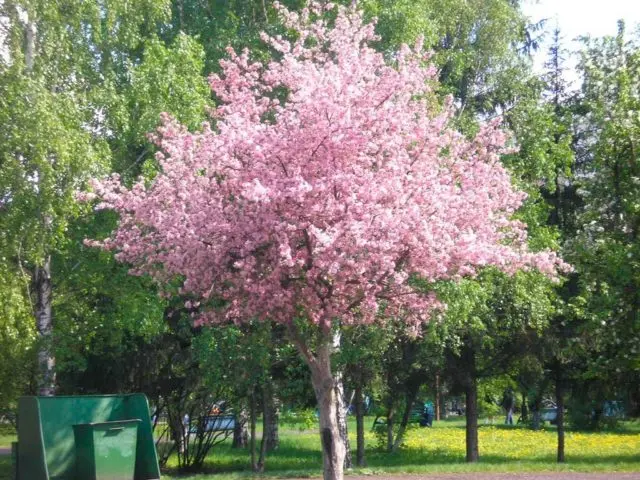
Decorative view is mainly used as an element of landscape design.
Columnar
Apple-tree columnar Chinese gold is an early-ripening species with high decorative qualities. The tree grows at a level of 2,0-2,5 m and has almost no lateral skeletal branches. In the columnar apple tree Kitaika, golden fruits grow in clusters along the main trunk.
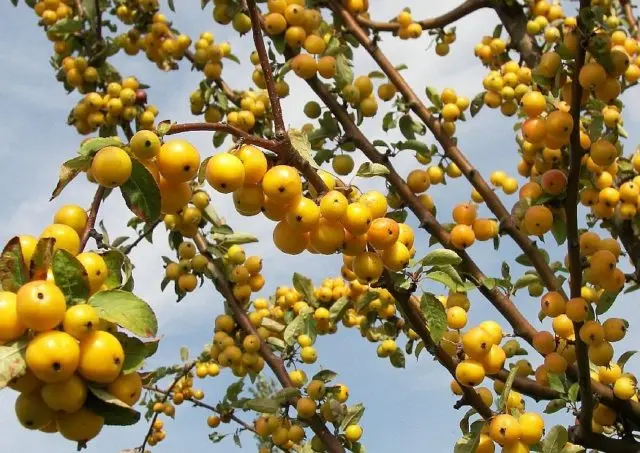
The shape of the tree of the columnar golden Kitayka greatly facilitates the care and harvesting
semi-dwarf
The height of this variety of Golden Kitayka does not exceed 3-4 m. Initially, the development of a young seedling is no different from the standard species, but after the first fruiting it noticeably weakens.
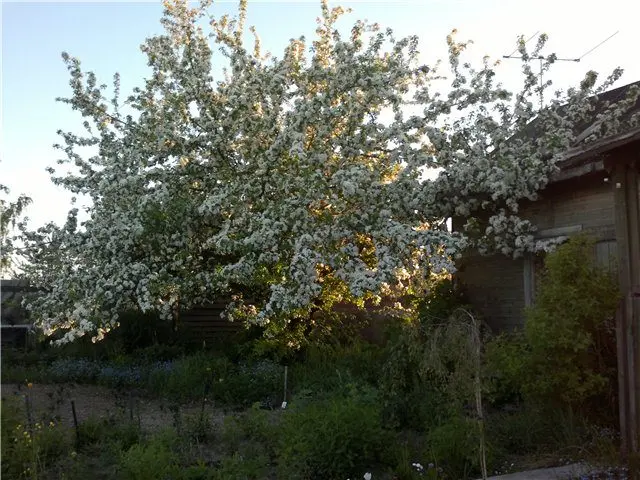
Experts recommend timely removal of old branches of a semi-dwarf species, which will stimulate the growth of new shoots.
Large-fruited
It is a low tree that easily tolerates low temperatures. According to the photo and description, this variety of Chinese apples golden differs from other types in larger fruits, the average weight of which is 60-80 g. The yield of the large-fruited species is high
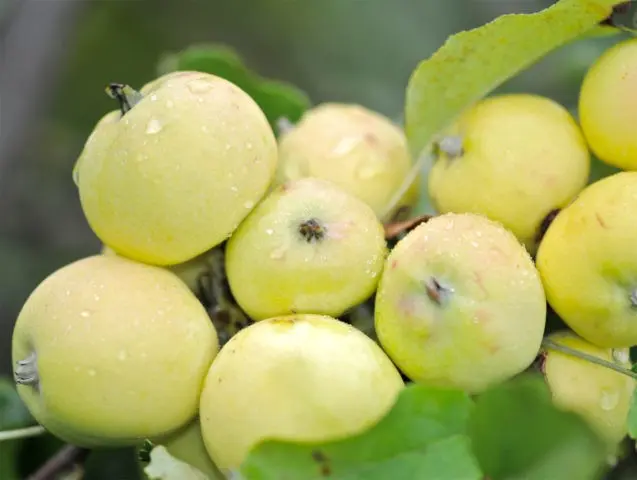
Large-fruited Kitayka withstands frosts down to -50 ° C
Advantages and disadvantages
Apple tree Chinese gold has a number of advantages and disadvantages. When choosing this type, you need to study them in advance.
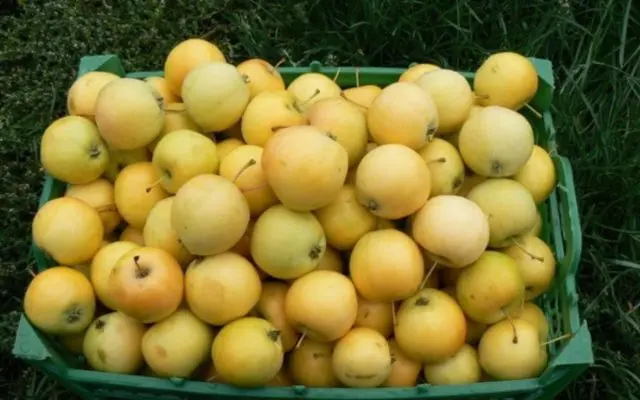
Chinese Golden when ripe exudes a pleasant apple flavor
Apple benefits:
- high decorative qualities of fruits and trees;
- increased frost resistance;
- stable fruiting;
- long productive cycle;
- precociousness.
Disadvantages:
- low resistance to diseases;
- fruits are not subject to long-term storage, transportation;
- needs pollinators;
- an early variety has a quick shedding of ripened fruits.
Planting and care
Apple-tree Chinese gold does not tolerate stagnant moisture in the soil. Therefore, when planting, the groundwater level must be at least 2 m. For a tree, you need to select a sunny area with protection from drafts. This species prefers loam and sandy soil with good air and moisture permeability.
In 2 weeks, you need to prepare a landing pit 80 cm deep and 70 cm wide. It is important to lay a broken brick at the bottom with a layer of 10 cm. And fill 2/3 of the rest of the volume with a nutrient mixture of turf, sand, humus, peat in a ratio of 2: 1: 1: one. In addition, add 1 g of superphosphate and 30 g of potassium sulfide.
Algorithm of actions:
- Make a small elevation in the center of the planting hole.

- Put a seedling on it, straighten the root shoots.

- Sprinkle them with earth so that the root collar is located at the level of the soil.

- Compact the soil at the base, water abundantly.
Further care involves timely watering in the absence of seasonal rains. Feeding the seedling should begin at the age of three. To do this, nitrogen fertilizers should be used in the spring, and phosphorus-potassium fertilizers should be used during the ovary and fruit ripening.
This tree does not require cardinal pruning. It is enough just to clean the crown from broken and damaged shoots.
Collection and storage
Harvesting of the early type should be carried out in the second half of July, and late – at the end of September. In the first case, the fruits are not subject to storage, so they must be used to make jam, preserves, compotes.
In the second case, apples must be placed in wooden boxes, lined with paper, and then lowered into the basement. In this form, they retain their qualities for 2 months.
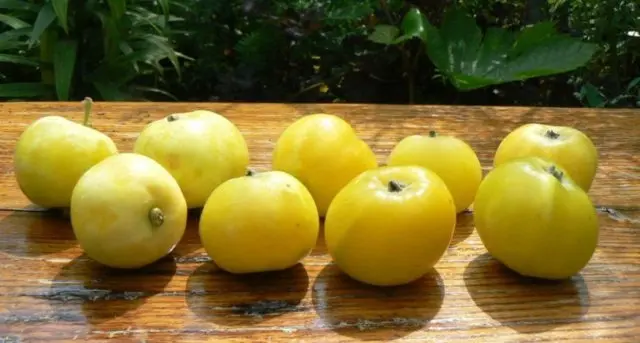
Chinese fruits are ideal for whole-fruit canning
Conclusion
The apple tree variety Kitayka Golden is an unusual species with small fruits that are ideal for winter harvesting. Graceful ranetok trees can decorate any site and diversify landscape design. According to experienced gardeners, the yield of other varieties increases markedly when planted near Golden Kitayka, as the aroma of its flowers attracts a large number of pollinating insects.











